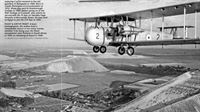Фотографии
-
The author in the front seat of the SAAF Airco D.H.9 flown by Lt Sandenburg - "Sandy";
Самолёты на фотографии: De Havilland D.H.9 - Великобритания - 1917
-
A typically vivid Charles E. Brown photo of a Vickers Victoria loading up at Heliopolis in the 1930s;
Самолёты на фотографии: Vickers Victoria - Великобритания - 1922
-
Victoria No 2 over Pretoria, the administrative capital of the Union of South Africa, where the tour arrived to great fanfare on March 8, 1934. The city was looking its best, as the squadron’s arrival in Pretoria coincided with a visit by HRH The Prince George, a keen advocate of aviation, who was on an official tour of South Africa.
Самолёты на фотографии: Vickers Victoria - Великобритания - 1922
-
As the flight proceeded southwards the terrain changed from the sandy desert of northern Africa to the savanna grasslands of Sudan and on to the mountains of the Eastern Rift range, of which Mount Kilimanjaro is the highest point. The port Pegasus of the author’s Victoria frames a magnificent view of a snow-capped peak.
Самолёты на фотографии: Vickers Victoria - Великобритания - 1922
-
A group portrait of No 216 Sqn in front of a Victoria VI at Heliopolis, Egypt, in 1934. The author is seated in the front row, fourth from left, as enlarged in the inset LEFT. The unit had long been established in Egypt, initially bringing its Airco D.H.10s to Qantara in 1919 before moving two years later to Heliopolis, from where it operated for the next 20 years
Самолёты на фотографии: Vickers Victoria - Великобритания - 1922
-
Регистрационный номер: K2343 [2] Resplendent above the clouds, Kilimanjaro recedes from view through the airframe of Victoria VI K2343, the author’s aircraft, probably after take-off from Moshi. At 19,000ft (5,800m), the perpetually snow-covered peak of Kilimanjaro would have been beyond the Victoria’s own absolute ceiling of 18,500ft. Next stop Dodoma ...
Самолёты на фотографии: Vickers Victoria - Великобритания - 1922
-
One of the series of photographs taken by the author from his Victoria during the squadron’s visit to Livingstone in Northern Rhodesia. It shows, appropriately enough, Victoria Falls and the distinctive arch of the Victoria Falls Bridge, which was opened in 1905 and straddles the border of what are now Zimbabwe and Zambia.
Самолёты на фотографии: Vickers Victoria - Великобритания - 1922
-
A keen photographer, the author kept a remarkable record of his many travels, whether it be flying over the Rand escarpment near Pretoria in South Africa in 1934, or refuelling at Asyut in 1935.
Самолёты на фотографии: Vickers Victoria - Великобритания - 1922
-
Регистрационный номер: K2807 Originally built as a Victoria Mk V, K2807 (No 1 on the tour) is seen here overflying the outskirts of Nairobi on March 2, 1934. The Victoria VI was essentially a Mk V with Bristol Pegasus engines replacing the original Napier Lions. With further structural strengthening the type was redesignated as the Valentia Mk I, and many Vs and VIs were ultimately converted to Valentia standard.
Самолёты на фотографии: Vickers Victoria - Великобритания - 1922
-
Регистрационный номер: K2343 [2] A keen photographer, the author kept a remarkable record of his many travels, whether it be flying over the Rand escarpment near Pretoria in South Africa in 1934, or refuelling at Asyut in 1935.
Самолёты на фотографии: Vickers Victoria - Великобритания - 1922
-
The remarkably clean interior of a Victoria (probably a factory-fresh example), looking aft. The type was originally designed to a specification drafted in 1920 for a troop-carrying aeroplane capable of carrying 25 fully-armed soldiers at 100 m.p.h. (160km/h) for 400 miles (640km). The prototype made its first flight in August 1922.
Самолёты на фотографии: Vickers Victoria - Великобритания - 1922
-
Регистрационный номер: J9655 Keeping the Victorias of No 216 Sqn company during the 1934 East African tour were four Fairey IIIFs of No 45 Sqn, based at Helwan near Cairo. The IIIF was powered by a Napier Lion engine, and it was presumably for the Faireys that a spare Lion engine was carried beneath the starboard wing of No 2 Victoria for part of the 1934 tour.
Самолёты на фотографии: Fairey Fairey IIIF - Великобритания - 1926
Статьи
- -
- A.Grandolini - Operation Bolo & Project Silver Dawn
- B.Harrison - Fairey's commercial break
- B.Livingstone - A tragedy of errors
- B.Taghvaee - Iran's Golden Crown
- C.Gibson - Shrinking pains: the aftermath
- G.Alegi - High, fast and forgotten
- M.Willis - Here come the Vixettes
- N.Forder - The War of the Roses air race
- N.Stroud - Indonesia's fledgling insects
- N.Stroud - Open wide! /The John Stroud Archive/
- P.Davidson - Off the Beaten Track...
- P.Jarrett - Lost & Found
- P.Ricco - Flag of Convenience
- P.Vabre - Premium parking
- R.Shaw - The Grand Tour











